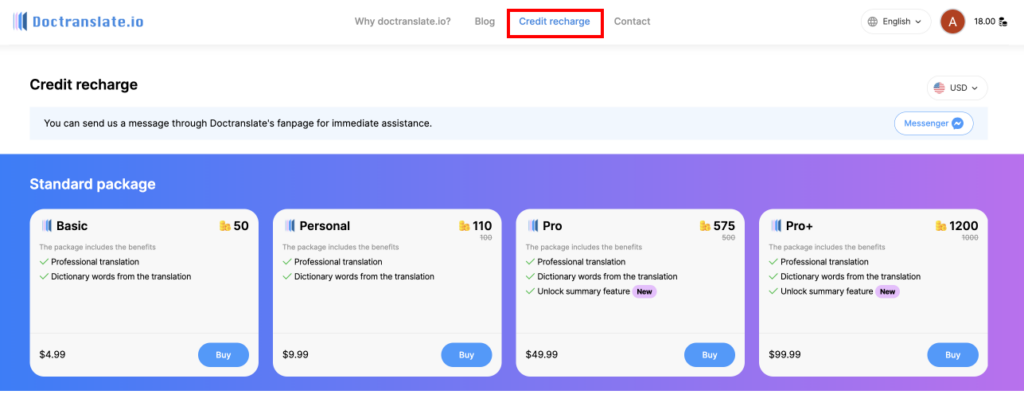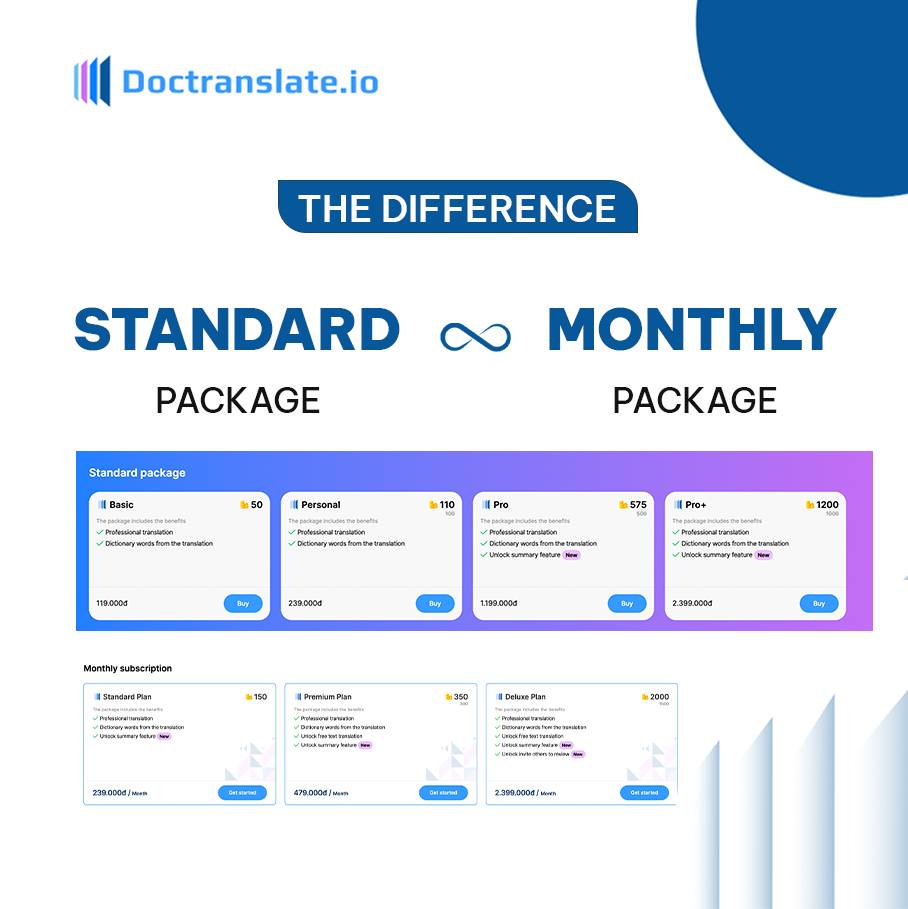Tips for Choosing the Suitable Credit Package: Basic or Monthly?
Credit on Doctranslate.io is a virtual currency used to pay for the platform’s translation services. Each time you translate, a certain amount of credit is deducted from your user account. When you register for a new account, you’ll receive 5 free credits to experience the product. To continue using the service after you’ve exhausted your free credits, users can purchase additional credits through Momo, ATM cards, PayPal, or debit/credit cards.
How to Top Up Credit
There are currently two methods to purchase credits on Doctranslate.io: basic credit packages based on the number of credits, and monthly subscription packages:
1. Basic Credit Top-Up Steps:
- Step 1: Select ‘Top-Up Credit’ at the top of the website.

- Step 2: Choose the credit package you wish to purchase from the ‘Basic Top-Up Package’ list and click ‘Buy.’
- Step 3: Select your preferred payment method (Momo, ATM card, PayPal, or debit/credit card) and proceed with the payment.
2. Monthly Subscription Steps:
- Step 1: Select ‘Payment’ at the top of the website.
- Step 2: Choose the credit package you wish to purchase from the ‘Monthly Subscription Package’ list (there are 3 options) and click ‘Subscribe.’

- Step 3: Select your preferred payment method (PayPal or debit/credit card) and proceed with the payment.
3. For Business Users
For users who are direct business registrants with Doctranslate.io, there is no need to top up credits. Each business account is provided with unlimited credits for usage, and the total expenses will be calculated and paid at the end of the month, along with the registered service package.
4. In Conclusion: Basic Package or Monthly Package?
The choice between the basic package and the monthly package on our platform depends on your specific needs and goals when using Doctranslate.io. Here are some factors to help you make the best decision:
1. Document Translation Needs:
- Basic Package: If you only need to translate specific documents or do so infrequently, the basic package may be suitable. It allows you to top up credits as needed and enjoy the benefit of 5 free credits upon registration.
- Monthly Package: If you have a high volume of monthly translation needs and want to access special features like text summarization or inviting others for reviews, the monthly package can be a cost-effective choice. It provides convenience and savings for users with high demands.
2. Special Features:
- Basic Package: This package is suitable for straightforward document translation without requiring special features like inviting others for reviews. If you only need to translate text, it may meet your needs.
- Monthly Package: If you need text summarization or want to invite others for reviews to enhance translation quality, the monthly package offers these features on-demand.
3. Usage Frequency:
- Basic Package: Ideal for users with sporadic translation needs. You can top up credits as required.
- Monthly Package: Perfect for users with monthly translation demands or frequent usage. This package provides cost savings for regular users.
In conclusion, based on your specific translation and feature usage needs, you can choose between the basic package and the monthly package on Doctranslate.io. Carefully consider your requirements and budget to enjoy the best translation experience.
The credit cost structure for business accounts differs from individual user accounts.
Credit calculation per translation mode:
- Document Translation (Documents)
- Accurate Translation: 1 credit = 1000 words
- Professional Translation: 5 credits = 1000 words
- Image Translation within Documents: 0.1 credit = 1 image/1 page PDF scan
- Text Translation (Texts)
- Accurate Translation: 1 credit = 1000 words
- Professional Translation: 5 credits = 1000 words
- Image Translation (Images)
- Professional Translation: 1 credit = 1 image/1 page PDF scan
- Audio Translation (Audio)
- Professional Translation: 1 credit = 1 minute”
Step into History: AR Brings 1800s Korean Royal Court Ceremony to Life
Introduction
In a remarkable fusion of technology and history, an innovative Augmented Reality (AR) experience now allows visitors to step back in time and explore a Korean Royal Court Ceremony from the 1800s. Set in the historic Gyeongbokgung Palace in Seoul, this AR experience offers a unique glimpse into the grandeur of Korea’s past.

Immersive Cultural Journey
Developed in collaboration between Cheil Worldwide, the Cultural Heritage Administration of Korea, Seoul Metropolitan Government, and woomihope.org, this project aims to increase public interest in South Korea’s rich cultural heritage. By recreating a royal ceremony from 1887 in AR, visitors can witness more than 300 elements of this historic event in a truly immersive way.
Bridging Past and Present
The AR experience virtually restores the Joseon Dynasty’s royal court ceremony, originally held 136 years ago. This digital revival is not just a showcase of technological prowess; it’s a bridge between past and present, allowing visitors to experience the splendor and cultural significance of the Joseon Dynasty in a modern, interactive format.
Educational and Engaging
This experience is more than just a technological marvel; it’s an educational tool that brings history to life. Visitors, both young and old, can learn about Korean history and tradition in an engaging and interactive manner. It provides a deeper understanding and appreciation for Korea’s cultural legacy, making history accessible and enjoyable for everyone.
Conclusion
The AR experience at Gyeongbokgung Palace is a testament to how modern technology can revitalize historical education and cultural appreciation. By stepping into this virtual reconstruction, visitors can experience a slice of Korean history, making it an essential visit for anyone interested in the rich tapestry of Korea’s past.
Elon Musk’s Remarks Prompt Brands to Quietly Withdraw from Twitter
The advertising landscape on Twitter, now known as X, is experiencing a significant shift. Following Elon Musk’s recent comments at the DealBook Summit and his criticism of advertisers, a phenomenon termed “quiet quitting” is emerging among brands.

Musk’s Criticism Leads to Brand Reticence
Elon Musk’s direct criticism of advertisers, including remarks about Disney CEO Bob Iger and the implications of advertisers leaving the platform, has led to a hesitancy among brands. Many are opting to quietly reduce their advertising investments to avoid public scrutiny and backlash.
The Wave of Quiet Quitting
Major corporations like Apple, Comcast, Disney, IBM, and others have already publicly stopped buying ads on X, citing brand safety and adjacency concerns. However, Musk’s comments have spurred a larger wave of brands to discreetly pull back their advertising efforts.
The Impact on Advertising Strategies
Brands are significantly reducing their investments rather than completely pulling out, signaling a cautious approach to their marketing strategies. Musk’s potentially confrontational response to brands moving away from the platform is a primary concern.
Notable Reductions by Major Brands
Prominent brands such as AT&T, Coca-Cola, and GM have reduced their year-over-year advertising spending on X by over 90%. This substantial reduction reflects a strategic shift in the advertising world, influenced by the platform’s evolving dynamics.
Corporate Decisions and Future Implications
The decline in advertising on X has been a result of decisions made at the corporate level. Musk’s dismissive attitude towards advertisers, who contribute significantly to X’s revenue, coupled with his controversial stance on free speech, has made the platform less appealing for many brands. The future of X as an advertising platform hangs in the balance, with Musk’s leadership style and comments potentially jeopardizing its viability.
Conclusion
Elon Musk’s recent comments have led to a notable shift in the advertising landscape on X. The trend of brands quietly quitting their investment on the platform reflects the growing concerns over brand safety, public perception, and the platform’s stance on free speech. This development could have lasting implications for X’s future as a key player in digital advertising.


